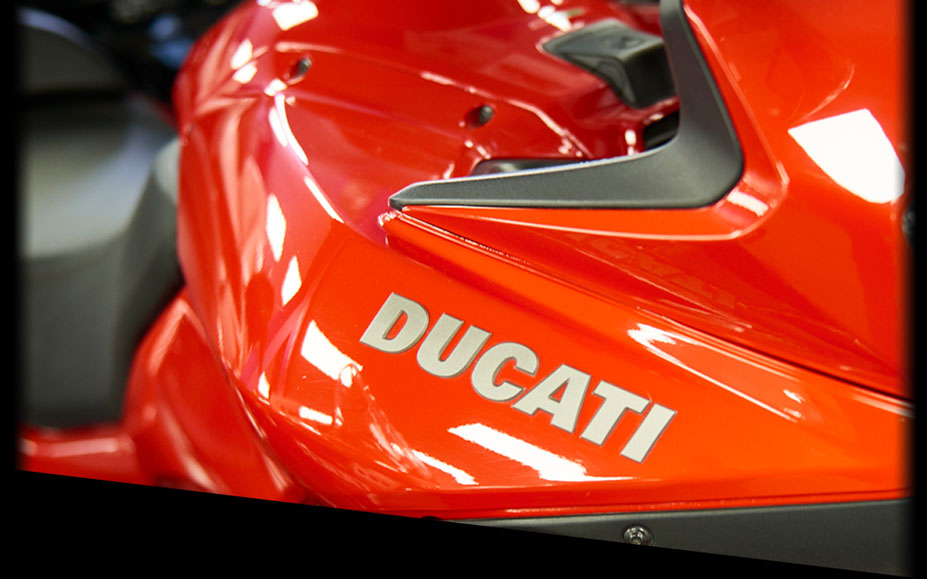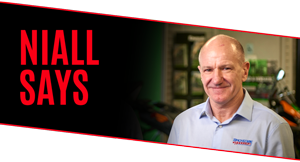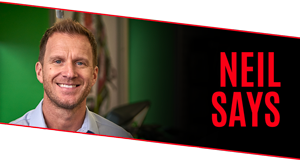
0333 0053 100

0333 0053 100


“I first became aware of Ducati as a result of hopping on a boat as a teenager from Ardrossan in 1979. My mate’s dad was racing on the Isle of Man that year, so I tagged along on the pretence of being a helper. That didn’t quite work out, so I went off each day exploring and generally soaking up the atmosphere of the incredible TT races.
It was only many years after I realised what a special part of racing history I had witnessed. I had seen all the stars, but I’ll never forget Mike Hailwood in full flight over the mountain on board the Sports Motorcycles Duke. Throughout my career, I didn’t spend a whole lot of time racing a Ducati although I am proud to say I still managed to qualify and run at the front occasionally in both British and world Superbike events.
Like many, I recognise the Ducati 916 is one special motorcycle even if the designers admitted they took a few styling cues from the Honda NR 750, such as the single-sided swinging arm, headlights, under seat pipes and indicators housed in the mirrors. The 999 didn’t really float my boat either but it did look good in race trim especially when my buddy NH was dominating the Superbike World Championship. But when it comes to the sports bikes from Bologna, my favourite has to be 1098.
I loved this bike from the first moment I saw one in the flesh at the world press launch in South Africa. As an all-new machine from the ground up, Ducati nailed things with this one in every department. Aside from looking amazing (from every angle), having an awesome new motor and sweet chassis, it also became the first production bike to offer the option of data logging for its owners. Needless to say, it became an overnight success both in the showrooms and racetracks, and a decade on still remains extremely desirable.
Ducati also has to be applauded for putting into production the mental 990cc Desmosedici MotoGP replica. Over the years, manufacturers have teased the public with plans to build race reps then everything goes quiet. Not Ducati though, this beast went into production and they didn’t cut any corners. Needless to say, the Desmo became instantly collectible with owners smiling as prices are rising every year.
All of the above are of course brilliant but money being no object, my Ducati of choice would have to be the weird and wonderful Diavel. Although they might look and sound a bit scary, I’ve ridden a few now and enjoyed every moment.
It’s
Ducati’s take on a cruiser and the Diavel can be a pussycat in town or a lion when letting loose on the open road. It can also be great fun on a racetrack as it accelerates and stops as good as many sports bikes. Just don’t ask it
to lean over too much or fly round hairpins!”

“What can I say about the manufacturer who dominated world Superbikes for so many seasons?
My personal relationship with Ducati played a massive part in my career. In my 20 years of circuit racing, over half of them were on-board the big V-twin. They were blood red, pulsating desmodromic valved, Italian stallions from Bologna. I think it’s fair to say Ducati was and still is, my soulmate of bikes. I’ve been asked many times why I got on so well with the Ducatis and, as you can imagine, I’ve thought long and hard about this.
In the end, I put it down to two major factors. Feel first. Ducati’s trellis frames allowed me to feel exactly what the front tyre was doing. I could feel the limit easily which is so important to any racers. Secondly, because of the way the Ducati produces power with that massive V twin engine, you always had loads of torque. Because of this, there was never a flat spot off the bottom when your RPM was really low, so I always had a connected feeling between my right hand, my backside, and the rear tyre.
I think it’s because of my motocross background I could always feel the limit, so once I was at the limit, I’d never burn a tyre out. Many times, I’ve been in races following riders smoking their tyres out while I’m just sat behind rolling the throttle off smiling knowing they were wasting the best part of their tyre. Ducati helped me achieve the unthinkable, from British championship race wins and a title in 2000 to a world championship in 2003.
Ducati also entered MotoGP in 2003 and it’s fair to say it’s been a rollercoaster ride ever since. They’ve had massive highs followed by huge lows and at times it looked like Ducati would never figure it out. What has impressed me the most is their 'let's throw everything at it' attitude, and you’d have to say it looks like it’s finally paying off. After what seems like an eternity since Casey Stoner's last wins on the bike, Ducati has now turned a corner.”
We specialise in getting the right insurance for our customers, so whether you ride the all-rounder Ducati Multistrada or the Diavel cruiser we will work to find Ducati insurance suited to you.
Applying for Ducati bike insurance through Mackenzie Hodgson could not be easier, get a quote online or over the phone through our expert call centre staff on 0333 0053 100.
So whether you are after comprehensive, third party fire and theft or third party only you can be assured that Mackenzie Hodgson will get you the cover you need.
It’s been a long journey from radio manufacturers to the builders of some of the world’s fastest and most exotic motorcycles, but there’s no doubt that this is the golden era for Ducati.
Like many modern day brands, the Italian company’s move into motorcycle manufacturing came in the years following World War Two. The Ducati family business had been established in the 1920s, producing components for transistor radios, but in
the post war era they looked to diversify and utilise their manufacturing facilities. In 1946, they were contracted to build 48cc single cylinder engines designed to be installed in bicycle frames.
More than 200,000 of these engines, called Cucciolo (puppy) in reference to the yapping sound of the exhaust note, were manufactured and, in 1952, the company introduced its own complete motorised bicycle using the Cucciolo engine. The company quickly
developed the machine, removing the bicycle pedals, adding a three speed gearbox and evolving the frame and fuel tank to create proper motorcycles.
The 1950s also saw a range of sporty single cylinder machines introduced under the stewardship of talented young engineer Fabio Taglioni. The company became active in racing and introduced Desmodromic valve actuation for its Grand Prix machines. Desmodromic valves are closed by a cam rather than a traditional spring, allowing for more accurate control of the valve and higher rev limits.
The mid-1950s Mercedes-Benz Grand Prix cars had used the system with great success and, in 1956, the Ducati 125
Desmo won at the 1956 Swedish Grand Prix. Ducati made the Desmo system its own, and it continues to be a trademark of every new Ducati on sale today.
The Sixties marked a strong period for the Bologna company with a popular range of single cylinder machines including the original Scrambler, which was made to satisfy the burgeoning US market, but the Seventies would be a tumultuous decade which
almost brought the company to its knees.
Despite many challenges, the 1970s did see the introduction of the 90-degree V-twin format (also known as an L-twin) with which the company has since become synonymous.
Taglioni started work on the new engine in early 1970, with a view to it powering a new generation of Ducati race bikes. In 1971, a 500cc version was built to race in international and Italian championship race meetings and in 1971 the 750GT was introduced.
One of the company’s most significant racing successes came in the summer 1972, when British racer Paul Smart won the Imola 200 on a Ducati 750, but away from the track the company was struggling.
Under government control, the company developed the L-twin motor to power a range of sporting road bikes from 500 to 900cc. In 1978 the company was taken over by diesel engine manufacturer VM Motori. That same year saw another major moment in Ducati
racing history, when the legendary Mike Hailwood came out of retirement to win the Formula One TT at the Isle of Man on a 900SS prepared by Sports Motorcycles of Manchester. The subsequent Mike Hailwood Replica production machine of 1982 proved
to be one of the most collectable models of all time.
The Hailwood replica also helped fill the coffers of an otherwise ailing company. By 1985, the company had changed hands and was in the ownership of the Castiglione brothers, who then owned the Cagiva brand. While funding remained a perennial problem
for the small Italian company, Ducati was innovative and created some of its most significant models in this period.
Talented designer Massimo Bordi designed new four-valve cylinder heads for the L-twin engine, which was also water-cooled and fuel injected. An experimental 750cc racer appeared at the 1986 Bol d’Or 24 hour endurance race and this led to the
Ducati 851 Superbike a year later.
While the 851 was a good bike, Ducati’s saviour came in the form of a new race series. In 1988, the Superbike World Championship was born – and Ducati were to be the main protagonists.
The first round of this new series took place on April 3 1988 and although there was only one ‘Bologna Bullet’ on the grid, former 500cc Grand Prix world champion Marco Lucchinelli rode it to victory. Ducati became the dominant manufacturer
in the series, as the 851 evolved into the 888, and by 1990 Ducati were world champions, with French rider Raymond Roche on top of the world.
In the showrooms, the Cagiva-owned Ducati revived the Supersport range. These featured the old air-cooled two-valve design in a steel trellis frame design for which the company was becoming famous. American racer Doug Polen obliterated the competition
to take the 1991 and 1992 Superbike series, while a young Brit called Carl Fogarty took his first ever world Superbike race win on an 888 in 1992 too.
A significant new model came in 1993, with the Monster M900. Essentially little more than a naked 900SS, the Monster opened up the brand to a whole new audience and contributed to a massive uplift in sales. Such was the success of the new model that
the Monster range has expanded and remains a core part of the Ducati range today, over 25 years on.
Clearly on a roll, Ducati introduced one of the most iconic and beautiful motorcycles of all time – the 916.
A stunningly gorgeous evolution of the 888, the 916 was stylist Massimo Tamburini’s finest hour. With its single sided swingarm, underseat exhausts and elegant twin headlights, the 916 was every bike the two-wheeled Ferrari, with performance
from the 916cc version of the L-twin motor making it competitive with the best of the Japanese Superbikes. The 916 range would go on to have a 10 year production cycle, gaining increasingly larger and more powerful engines as it evolved into the
996 and finally 998.
The 916’s good looks were enough to make it the poster bike of its generation, but these were backed up with race results that made it the most successful Superbike of all time. Fogarty gave Ducati four world championships between 1994 and 1999, while Australians Troy Corser and Troy Bayliss took a title apiece.
In the UK, Bayliss broke Niall Mackenzie and Yamaha’s stranglehold on the British Superbike Championship by winning the title in 1999, with Neil Hodgson, John Reynolds,
Steve Hislop and Shane Byrne giving the 996/998 a five-year streak of British titles. A smaller model, the 748, was also available and proved to be a popular alternative to 600cc fours in the supersport sector.
Following the 916 was a tough act to follow and that job went to South African designer Pierre Terblanche, who penned the 999. Although technically a better bike than its predecessor, the 999 lacked the sex appeal of the iconic models that had gone
before it. The triple nine was still a big hitter on the race track, with Hodgson and fellow Brit James Toseland adding to Ducati’s list of world Superbike championships.
Alongside world Superbikes, Ducati also returned to Grand Prix racing in 2003. Bayliss and Loris Capirossi raced a new V4 (technically an ‘L4’) racer called the Desmosedici. Although a four, rather than a twin, the GP racer retained the key Ducati characteristics, like the Desmodromic valve train and steel trellis frame.
The Ducati MotoGP project has had its highs and lows, but Casey Stoner gave the Italian factory the ultimate prize in 2007 when he won the world title on the
800cc Desmosedici GP7. The early years of the GP project also saw a limited run of 1500 990cc road going replicas released. Based on the 2006 GP6, the Desmosedici RR made 200bhp and cost £40,000 when new. It also became an instant classic.
In Superbike racing, Ducati remained a formidable force, even though rule changes gave the four-cylinder competition the upper hand. Eventually twins were allowed a 1200cc capacity and the 1098R became Ducati’s production racer. Bayliss and
Carlos Checa would go on to win titles with this model.
Today’s Ducati range is the most diverse ever. Naturally the headlines are about the Superbikes, but the overall range is bigger than it has ever been and offers something for almost every motorcyclist on the road. These days the company is
owned by car giants Audi, themselves part of the Volkswagen group, and the modern day Ducati have proven themselves to be geniuses at marketing as well as engineering.
A rebooted version of the Scrambler arrived in 2014, complete with a modern version of the air-cooled 803cc L-twin has taken Ducati to a whole new audience. Indeed, the retro Scrambler range has become a brand in its own right with 12 different models
from 400-1100cc.
The Monster range remains in rude health too, with a six model range that runs from entry level air-cooled bikes to a fire-breathing 150bhp 1200R. Under its new management, the Multistrada has metamorphosed from an unloved ugly duckling to a cutting
edge sports tourer-cum-adventure bike, with the Diavel and SuperSport further broadening the appeal of the Ducati brand.
But the sports bikes and racing image remain at the core of Ducati’s ethos. The company remains front runners in the Superbike and MotoGP world championships, while the latest Panigale V4 flagship has seen the company switch from its famous
L-twin to a V4, in the style of its MotoGP bikes.
Whatever the future holds for Ducati, it has come a long way from the family owned transistor radio manufacturer of the 1920s, never mind the perennially broke organisation of the 1970s and 1980s. These days Ducati is right up there as one of the
most desirable and recognisable brands, with a hardcore following – the Ducatisti.
Forza Ducati!